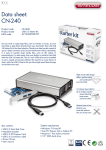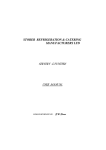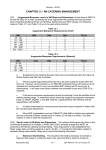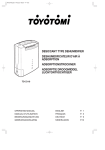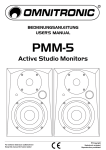Download Documentation Operating Instructions Rollers
Transcript
PRECISMECA - MONTAN Gesellschaft für Fördertechnik mbH Documentation Operating Instructions Rollers PRECISMECAMONTAN GmbH Section Operating Instructions No.: T311-00 Index Rev.: 0 Page: 1 of 1 Document No. Pages Preface T311 - 01 1 Safety T311 - 02 1 Technical data T311 - 03 1 Description and operation T311 - 04 3 Commissioning T311 - 05 3 Maintenance and inspection T311 - 06 1 Repair T311 - 07 1 qnw/betr-eng.doc PRECISMECAMONTAN GmbH PREFACE No.: T311-01 Rev.: 0 Page: 1 of 1 With an increasing streamlining of manufacturing and handling processes, reliable conveying equipment components such as idler rollers gain ever more importance in ensuring a high degree of availability of belt conveyors. Bulk goods and cargo need to be handled quickly and efficiently under ever harsher conditions. Idler rollers and idler roller stationes manufactured by PRECISMECA-MONTAN are reliable, functional products of high service life made on sophisticated engineering equipment. The idler rollers and their components are designed and dimensioned to suit the specific use. Idler rollers are mainly designed for use: - as components of rigid idler roller stationes for installation in idler roller supports, bolted or clamped to the belt frame , - in articulated idler roller stationes in combination with various suspensions on the belt frame , - as roller conveyor components for handling cargo; - as carrying elements in pipe - conveyors. qnw/betr-eng.doc PRECISMECAMONTAN GmbH SAFETY No.: T311-02 Rev.: 0 Seite: 1 of 1 Idler rollers are rotating conveying elements which should be mounted so that the operator is not subjected to any hazard. However, it cannot be excluded that idler rollers of idler roller garlands fail during operation. Continuous monitoring of idler rollers and idler roller garlands is hence imperative. Any defective idler rollers or garlands shall be replaced immediately, or disengaged through lowerators, if possible. When stopping the belt conveyor note that hot rollers (heat generation through bearing damage) may constitute a severe fire hazard to stopped rubber conveyor belts. Restart the belt conveyor immediately, if required to avoid fires. If a roller runs hot and/or there is smoke emanating from the conveyor bring the latter to a controlled stop and fight the heat source using appropriate fire fighting equipment. Comply with relevant safety regulations and instructions to avoid hazards form unintentional belt restarts. The belt conveyor manufacturer should provide the relevant safety equipment as specified for the operation of belt conveyors. qnw/betr-eng.doc PRECISMECAMONTAN GmbH TECHNICAL DATA DESIGN Nr.: T311-03 Rev.: 0 Seite: 1 von 1 PRECISMECA-MONTAN idler rollers are supplied with the proven PRECISMECA sealings. The high quality standard is based on: • idler roller tubes acc. to DIN 2458, with tight tolerances, electrically welded, • low balance error steel bearing-houses, welded to the idler roller tube all around; • ball bearing seats calibrated in the bearing-houses fitted so that the ball bearings as installed have the necessary clearance; • precision deep groove ball bearings acc. to DIN 625, bearing clearance class C3 or C4 resp.; • long-term lubrication using high-grade special-purpose grease; • proven sealing system, including: external sealing including end cap and axial sealing, multiple labyrinth seal, internal sealing to keep the grease inside the ball bearing, to limit the breathing process, and to prevent rust from penetrating into the ball bearing = 6204 qnw/betr-eng.doc ≤ 6308 > 6308 PRECISMECAMONTAN GmbH DESCRIPTION AND OPERATING PROCEDURE Nr.: T311-04 Rev.: 0 Seite: 1 von 3 Idlers for application in belt conveyors PRECISMECA-MONTAN idlers have established themselves over many years and are, depending on the type of connection, suitable for installation in rigid support constructions or for insertion into the framework as garlands. They differ from the standards as set out by VDI 2341 regarding single components in accordance with the specific purposes for which they are intended. Usage characteristics : - As part of idler stationes in idler carriers or brackets carrying and reversing tracks in conveyors belts; - In "garland - form" for assembly into stationes using connecting pins; - For heavy load-carrying capabilities of the idlers and the assembled stationes; - For inside or outside use; - For maintenance-free lasting use; - For conveying speeds of up to 10 m/s, depending on the diameter of the idler; - For surrounding temperatures of -35 to +50° C. The idlers have on common construction which brings together many years of experience. The most important parts are: - Idler - tube - Bearing houses - Idler axle - Radial groove bearings - Sealing block - Securing elements qnw/betr-eng.doc PRECISMECAMONTAN GmbH DESCRIPTION AND OPERATING PROCEDURE Nr.: T311-04 Rev.: 0 Seite: 2 von 3 The PRECISMECA - MONTAN idler design uses a continuous axle with internal bearing. Lubrication of the rolls is not necessary for the whole period of use due to the guaranteed long-lasting lubrication of the lithium-added grease used. The supporting points of the idlers are sealed, so they can be used in the most varied cases in industry and are well protected from dirt and damp getting in. Rolling resistance lies under the norm set out by DIN 22 112, which, especially with long conveyor belts, is important in determining conveyance chracteristics. So lowest running costs are possible. Full exchangeability of idlers of the same type ist guaranteed. Construction characteristics of the single components - Idler tube Idler tubes are made of welded precision steel pipe according to DIN 2458. The contact side is chamfered. So the required tolerances for practical use can be guaranteed according to DIN 22112 for turning and VDI 2060, Q 60 for uneven load. - Bearing housing In accordance with the requirements the bearing housings are made of special deep-drawn quality sheet steel with high accuracy. With the calibrated M7 bearing seat, the roller bearing ist guaranteed a firm fit onto the bearing housing. For heavy duty applications the material used is a solid bearing housing, which is measured out according to the measurements of the other parts. - Idler axle The idler axles are made out of round steel (bright steel). Idler for rigid mounting have axles with dihedrals. The dihedrals by so fit securely into the insertion slits of the idler support of the full length of the support - profil. The idlers for the garland-combination are intended for connecting pieces - chain links qnw/betr-eng.doc PRECISMECAMONTAN GmbH DESCRIPTION AND OPERATING PROCEDURE Nr.: T311-04 Rev.: 0 Seite: 3 von 3 - Roller bearings The applicable roller bearings of the ranges 62, 63 and 312 with the air group C3 guarantee a high carrying performance of the single idlers and of the whole idler station. - Sealing and securing parts In front of and behind the roller bearings, there are special sealing discs made of durable plastic. They ensure that the right amount of grease to provide proper lubrication on the on hand and that the rolling resistance is kept to a minimum on the other hand, keeping the grease inside the bearing mechanism. At the same time, the bearings are kept free from influences from the inside of the idler mechanism such as condensation. In front of the roller bearing a suitable axial support towards the outside and a labyrinth sealing system is preinstalled components, which controls the intrusion of dust and damp. Selected plastics and their design ensure durability and functionality. The entry gap in out sealing system was chosen so that rainwater cannot get in if the rolls are tilted up to 70°. Over 70° tilting and for idler-cleaning with water-stream , we recommend to use spring-water-protecting-caps on top of the idlers. The intrusion of dust is hindered using very narrow gaps. Apart form that, cnetrifugal force acts against the further intrusion of dust onto the idlers. A further feature of the sealing block ist the interaction of large chambers and narrow gaps. With this, the air flow rate due to the "breathing", that is, the equalisation of pressure between inside and out, of the idlers is reduced. So the dust suction effect is reduced. In order to protect the idlers form mechanical demage during running a stable steel sheet cover for the whole bearing is advised. qnw/betr-eng.doc PRECISMECAMONTAN GmbH COMMISSIONING Transportation and storage, installation of stations and idler rollers Nr.: T311-05 Rev.: 0 Seite: 1 von 3 1. Transport The idlers can be transported in collis or with wooden palettes bundled. Mounted idler-garlands can be transported with wooden sledges , bundled. The collis have to be fastened using 2-core fastening cable. If Load bands are to be used, single core bands are to be fastened on the same direction as the surrounding steel bands loops. While lifting , the package has to be kept balanced. Do not lift the package by steel loops or by the axle ends. When transporting with fork - lift truck using wooden palettes . 2. Storage The idlers and their accessories have to be stored so that their function is not impaired. If they are not properly stored, damp and dust can get into the sealing and therefore into the idlers. An earlier breakdown would be the result. Sunlight (UV-rays), heat and heavy temperature changes promote aging and cracking of rubber and plastic parts. The parts should be stored indoors and there should be a ground clearance of at least 100mm. Should these requirements be impossible to meet, the following guidelines apply : - Parts can be stored in the open for up to 6 months after delivery, without covering up. If the ground underneath is solid, the ground clearance should be at least 100 mm. If the ground is loose, then at least 300 mm. - If the parts have to be stored in the open for more than 6 months, the assemblies or single parts must be water and weather-proofed. The covering has to be carried out to avoid condensation. - The climate and temperature of the storage place or room has to match those in running conditions. (Temperature -35° to 50° C, air humidity up to 95%) The storage should be in secure piles. Only up to 3 assemblies should be piled on top of eachother, so long as the ground underneath is solid and even. On no account pile on soft ground. The steel loops should only be loosended once the idlers have been removed. Thereby is a security against rolling of the idlers placed. qnw/betranl.doc PRECISMECAMONTAN GmbH COMMISSIONING Transportation and storage, installation of stations and idler rollers Nr.: T311-05 Rev.: 0 Seite: 2 von 3 3. Installation of fixed idler roller stations A differentiation is made between idler roller stations with and without a roller tilted position. For stations with a tilted position care should be taken to have the tilting position run in the running direction of the conveyor. The idler roller supports are marked with a little arrow which should point in the conveying direction. Idler roller supports which have a cross hole to take up the idler roller should be installed into the belt frame so that the idler roller is pressed against the angle brackets provided in the conveying direction. The idler roller axles should rest uniformly on the brackets and be fixed in place using appropriate fixtures. Use good fixtures to securely mount the complete station onto the belt frame. If idler roller supports with ties of cold or hot welded U-sections are used make the screwed connection on the belt frame so that the U-sections do not deflect. We recommend to use supporting sleeves or washers acc. to DIN 440. For safe seating of the idler rollers in the support provide the idler roller axles with dihedrons which should match the jogs of the receivers in the support. If the idler rollers are to be secured against tripping, mount the locking elements after the idler rollers were installed, beginning with the centre roller or support centre resp. Any additional loads from the belt guide should be considered in designing the idler rollers (cf. VDI 2341), and positively eliminated during installation and operation. Without these loads being adequately considered the maximum admissible angle deviation of the belt at the idler roller of 1 degree should not be exceeded. qnw/betranl.doc PRECISMECAMONTAN GmbH COMMISSIONING Transportation and storage, installation of stations and idler rollers Nr.: T311-05 Rev.: 0 Seite: 3 von 3 4. Installation of articulated idler roller stations (garlands) Use commercially available standardized roller chain links or customized screwed coupling links to assemble the idler rollers to idler roller garlands. Roller chain links These are elements of roller chains acc. to DIN 8187. Secure the loose butt straps of the links in place using steel pins. Bend the pin ends by ca. 10 degrees using a socket spanner with slots. Take the pins once only. Screwed coupling links Insert the loose socket pins through a coupling link butt strap and through the bore of the idler axle or suspension link resp. Push on the second butt strap from the other end, and secure in place using self-locking nuts acc. to DIN 985. Insert all coupling links of an idler roller station from one and the same end. Suspend the articulated idler roller stationes in the supporting structure using hooks, butt straps or customized suspensions (including spring-type ones). The coupling links allow the idler rollers to move in an vertical direction only. That is why the suspension links are designed so as to allow the station to swing in a horizontal direction. Suspend the articulated idler roller stationes in the belt frame so that the loose coupling link butt straps are arranged in the direction opposite to the conveying or direction of belt run. Arrange the nuts of the screwed coupling links in the direction opposite to the direction of belt run. This is to reduce the load acting on the locking and retaining elements. Be sure the articulated idler roller stationes are free to move. Any additional loads from the belt guide should be considered in designing the idler rollers (cf. VDI 2341), and positively eliminated during installation and operation. Without these loads being adequately considered the maximum admissible angle deviation of the belt at the idler roller of 1 degree should not be exceeded. Avoid any tilt of the idler roller garlands of more than 2 degrees in case of sloping - descending or ascending - conveying arrangements. qnw/betranl.doc PRECISMECAMONTAN GmbH MAINTENANCE and INSPRECTION Nr.: T311-06 Rev.: 0 Seite: 1 von 1 The idler rollers, idler roller supports and garland stationes are maintenance-free. The ball bearings of the idlers are permanently lubricated and protected against contamination by seals. However, continuous monitoring of the idler rollers and idler roller garlands is still imperative. Immediately replace any defective idler rollers or garlands, or disengage using lowerators. This is specifically necessary if one or several of the following occurs: - bearing deffects and / or abnormal running sound, which announce demages; - axial locking device fails (roller jacket clearly offset); - axle broken (in case of welded axles); - jacket tube damaged or completely worn; - supporting rubber rings worn to cylindrical base or completely damaged; - coupling link damaged. If the above defects are ignored and the affected parts are not replaced without delay this may result in damage to the material to be conveyed or to other components of the conveyor system. Be sure to avoid any material accumulations that reach into the idler roller running area. Regulary remove any piling-ups, avoiding material penetrating into the sealing area. qnw/betranl.doc PRECISMECAMONTAN GmbH REPAIR Nr.: T311-07 Rev.: 0 Seite: 1 von 1 It is recommended not to perform any repair on the idlers. Replace any defective components to maintain the idler garlands in good condition. Use original parts to ensure good functioning and full load-bearing capacity. Maintain the direction of rotation when removing and inserting idlers. Mark the existing rotational direction prior to removing any idlers. qnw/betranl.doc













